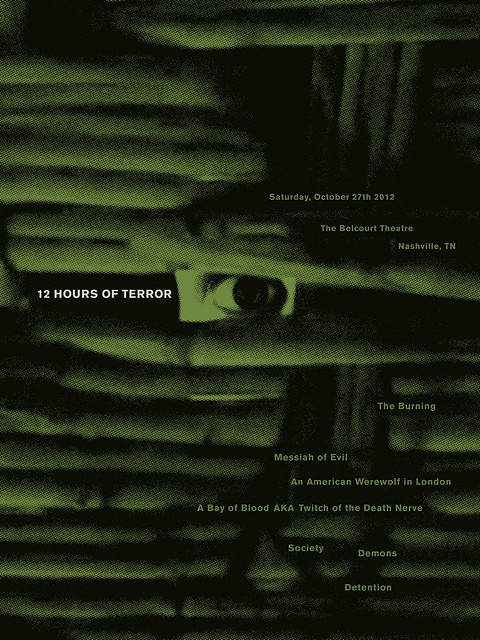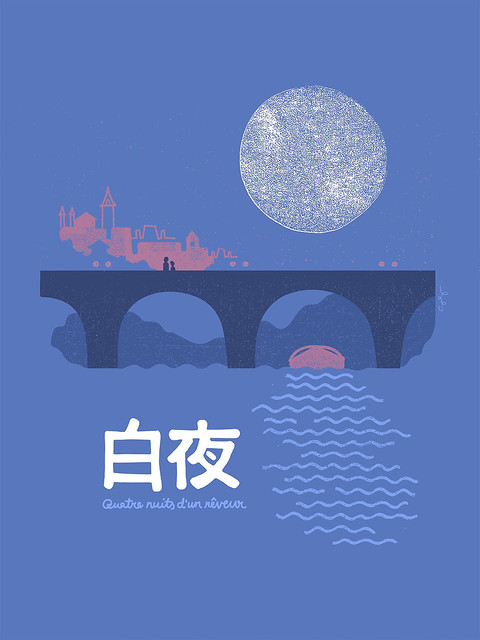In my work for Criterion I've had the chance to work on several dream projects-- from daunting classics like Tarkovsky's SOLARIS and Criterion's first Chaplin release MODERN TIMES to new discoveries like HOUSE that are now among my favorite films. Films by Demme, Assayas, Shindo, and Fassbinder. But getting to work on Godfrey Reggio's QATSI TRILOGY was really my number one dream come true; KOYAANISQATSI has always been a film I'd put in my own personal Sight and Sound list of the best films ever made, and I've always fantasized about it-- along with its counterparts POWAQQATSI and NAQOYQATSI-- being in the collection. The process of designing a package for Reggio's trilogy was daunting, fun, and it evolved in a way I didn't at all expect.
When I first heard through the grapevine that these titles were in the works at Criterion, I did something I've never done before but have always wanted to do: I spent a night designing a mockup treatment for the entire box set, printed out the images, glued them to my THREE COLORS TRILOGY Blu-ray set (I later purchased a replacement), took some quick photos, and sent it all over to Criterion, unprovoked. (click all images to enlarge)


These films have meant a lot to me for quite a while. My dad, an artist who kept up well with 80's avant-garde trends, first introduced me to both KOYAANISQATSI (taped onto VHS) and the music of Philip Glass, who would score all three of these films. I later came to POWAQQATSI through Glass's soundtrack, and in college, I saw NAQOYQATSI at an NYU screening with Reggio and Glass in attendance, while I was studying there in the Cinema Studies department. Being as familiar with the trilogy as I was, I eagerly re-watched all three films in that one night and took new notes considering the themes that needed to come through in the design. I wrote my own outlines of the films to help better process the films' narratives (though they don't have any dialogue or characters, they are in a sense narrative films), and doodled some ideas for possible cover solutions and title treatments.


As I watched the films and took screengrabs, I happened upon four images that I felt could represent the three films and the trilogy as a whole. For a set of films so densely packed with incredible images, I surprised myself with the conviction that these individual shots could actually stand for the films as a whole. But they each played into a theme Reggio speaks about that I really connected with: the idea of taking the background of our world-- the scenery behind us that we take for granted-- and making it the foreground, and in doing so, transforming how we see and understand the world. To see from a new perspective the way in which civilization has overtaken the natural world, how modernization has transformed the purity of humanity and culture, and the death of the natural world as we have migrated into the digital world. For the booklet cover I used an image from NAQOYQATSI of a skydiver in freefall over an abysmal cosmos, with the films' three "taglines" placed on top; These Hopi translations of the film titles are the audience's main entry point to the films' themes: Life Out of Balance, Life in Transformation, Life as War.

These cover images, I thought, each made their own unique abstract pattern, tying into Reggio's idea of presenting our world in a new perspective. And each, I felt, tied into the film's themes: The clash (and mirroring) of nature and civilzation in KOYAANISQATSI, the beauty and grace of indigenous cultures in POWAQQATSI, and the twisted virtual reality as presented in NAQOYQATSI. On the slip cover, another shot from KOYAANISQATSI shows our world at even greater vantage point, further abstracting our landscape into something new, where a city looks no different than a microchip.

My instinct with the typography was to re-brand the trilogy in a fresh way, respectfully setting aside the original bold, red title treatments in favor of a more 80's modern, Eno-inspired clean typeface, spread across each image in a languid, meditative presentation. I mocked up a couple of menus and the back of the box as well. Soon after taking a look at the images, Criterion let me know I got the job, and that we would work out the details. I was thrilled, but surely it couldn't be as easy as that...

I really liked this initial design, and would have been happy putting the stamp on it and calling it a job well done, but the team at Criterion always has a good instinct on when to keep pushing, exploring, seeing if there's something even better. After some further processing and meeting with the filmmaker, Criterion wanted to try using the original title treatments after all, so I put them over my original cover images. I was sad to let go of my original type, and missed how it felt going gently through the center of each image. The original titles were bold and blocky, and would be tricky to integrate into such open, abstract images. But I knew that through the process, we could find a way to integrate them in a satisfying way. I also would need to replace the slipcase cover with another image that served the same function but, having less contrast, could host the titles more legibly.

There was more brainstorming among the producers and filmmaker, and the thought came to pursue other possible images for each cover to make sure that we weren't missing something better. I thought the KOYAANISQATSI building shot was perfect, and I loved the other two images as well. All three reinforced the idea of abstract perspective (looking up, looking from a distance, looking from above), and as a bonus, I thought all of the colors looked great together. But in the interest of pushing further, I looked for other images that could work. Images from KOYAANISQATSI that represented speed and acceleration (something the building cover didn't really hit); Closer, more intimate images of the laborers in the opening of POWAQQATSI that embraced their humanity and their struggle; And for the slipcase, the idea was presented that we should really try using the petroglyphs seen at the beginning of KOYAANISQATSI as an icon for the whole trilogy.

Reggio wanted to consider some imagery from the opening of NAQOYQATSI, so I looked at other options for this cover. One shot in particular echoed the KOYAANISQATSI building cover perfectly, representing a transformation from grandeur to decay. At this time we were also looking at new options from POWAQQATSI's opening, like this shot of the laborers hauling through a mud field that reflected the sky above. And we went back to the natural cave-wall tones for the slip cover, feeling that my more graphic treatment of the glyphs was too stylized.


With the above spread, we all felt that we had arrived at a satisfying conclusion for the package. Already, it had evolved quite a ways from my original mockup. But just as we were settled on this, Criterion gave me the push to go even further and try all new covers that attempted something we had been avoiding: integrating multiple images on each cover. Did the single images, while representative of each film and interesting in relation to each other, really stand alone as individual covers worthy of their films? And could we not pay better tribute to Reggio's style by embracing the multitudes, the dream-like flow of imagery that defines these films' aesthetic? I knew that we had to avoid the dreaded Grid of Images, the obvious fallback solution for having too many great images to choose from. I've never been much for Photoshop trickery, collaging and layering, but I looked at this as a unique challenge to experiment in a new style that would hopefully avoid the usual cliches of multiple-image layouts. It turned out to be extremely liberating and fun, with interesting results coming easily that felt fresh, full of movement, color and energy.


The single-shot covers suddenly looked inert and dull. The new covers, which inadvertently created their own kind of triptych landscape, felt inspiring and exciting to everyone. With KOYAANISQATSI I could play with the overlaying of civilization on top of a natural landscape and with Reggio's images of acceleration. With POWAQQATSI I could capture Reggio's slow-motion embrace of people, their natural habitats, and the encroachment of modernization onto their world. NAQOYQATSI, itself a manipulated digital collage, allowed for even more experimentation, where I could integrate the decaying buildings, digital space, and machines of war into a virtual landscape at dusk. After a long process of carefully exploring every option for every cover, twice thinking that we had the problem solved, it turned out that a fresh start provided the best and quickest solution.

The DVD menus and booklet provided an obvious opportunity to simply present some of the trilogy's many great images and let them speak for themselves, while carrying over my collage style into the digipacks and Blu-ray menus (which were done in-house at Criterion, beautifully riffing off the cover styles).


Working on THE QATSI TRILOGY has been a highlight of my design career, and I'm honored to have had my original pitch considered, and then to have been allowed to explore further possibilities that pushed me in unexpected and rewarding ways. It was a long and unpredictable transformation from conception to completion, but I couldn't be more proud of the result and excited for fans and new viewers to discover and enjoy this trilogy of films-- films that I believe are profoundly important to our current global paradigm, not to mention aesthetically visionary and groundbreaking. KOYAANISQATSI cinematographer and time-lapse pioneer Ron Fricke earned great acclaim for this year's SAMSARA, a 70mm portrait of our planet that must be considered one of the great accomplishments in contemporary filmmaking. To see where this style began, discover THE QATSI TRILOGY from Criterion, out now on DVD and Blu-ray. Happy holidays, and enjoy!

























































